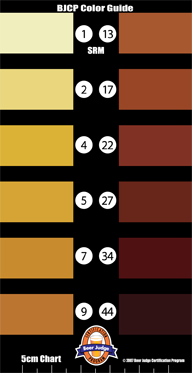-
Introduction
The Beer Judge Certification Program is pleased to present to you our new BJCP Color Guide. This guide is a free member benefit for all active judges in the BJCP. We offer it to you as an education and training tool primarily, although you may find that it has some utility in a competition setting.
The new BJCP Color Guide is designed to allow a beer judge to quickly estimate the color of a beer sample in SRM (Standard Reference Method) units. The color samples printed on the guide have been calibrated using precision test equipment and are intended to be used with a 5cm path in daylight. A convenient measuring aid is printed on the guide.
The guide concept was inspired by the Davison Color Chart, which has not been manufactured since the 1990s.
A single-page PDF version of these instructions is available for download, and is the same sheet included with the color guide.
We had 20,000 copies of the guide printed in the initial production run. One was sent to each active BJCP judge in May 2008, and copies were also handed out at the AHA NHC in Cincinnati. The guide is also being sent to all new judges with their exam results, and to all newly promoted judges with their promotion packet. Additional copies of the guide, either replacments or additional copies for training classes, may be requested at any time (see ordering instructions below).

Instructions for Use
- Measure a sample of beer in a clear glass or hard plastic cup with a path of 5cm (use the bottom edge of the guide as a measure). If the glass is not 5cm wide, pour a depth of 5cm and look down through the beer.
- Use a pure white sheet of paper or white tablecloth as a background.
- Use a natural light source or artificial light approximating sunlight. Do not use a flashlight to provide extra light. The guide and the beer must be viewed using the same light source. Avoid casting shadows with your body or the beer glass.
- Look through the beer at the white background.
- Place the BJCP Color Guide next to the beer so that the beer (as viewed with the white background) and the guide can be seen together. Compare the colors and find the closest match. An exact match is unlikely, so look for the closest lightness/darkness match rather than attempting to match hue. If the sample is in between two color patches, interpolate.
Care and Handling
The BJCP Color Guide is durable, but not indestructible. Treat it with some care, particularly in avoiding scratching the color surface. The Guide is water-resistant, and may be cleaned with water and a soft cloth. Avoid prolonged exposure to water or beer, especially the edges. You may find wrapping it in a cloth handkerchief a convenient way of protecting it when not in use.
Ordering Replacements
For a free replacement color guide, send a stamped, self-addressed envelope to:
BJCP, Inc.
5115 Excelsior Blvd, #326
St. Louis Park, MN 55416
Attn: Color Guide ReplacementPlease allow 4-6 weeks for delivery.
Technical Background
The BJCP Color Guide is designed to help you estimate the color of a beer in SRM units (standard in the US for over 50 years). In a laboratory SRM (Standard Reference Method) is determined by measuring the diminution in the intensity of a beam of blue light (430 nm) as it passes through 1 cm of beer. SRM is the logarithm of the light loss (absorption) multiplied by 12.7. The European EBC color is determined in the same way except that the multiplier is 25. This means that the Guide can be used to estimated EBC as well as SRM color. Simply multiply SRM values by 1.97. Example 10 SRM is equivalent to 19.7 EBC.
The Guide was prepared by measuring the spectral absorptions of approximately 100 beers. The data were used to calculate the colors of average beers with the SRM values printed on the guide The printer was asked to reproduce these colors as accurately as possible. Your ability to match the colors on the Guide to the color of a beer you are examining is limited by the fact that a given beer’s color may differ from the color of the average beer of the same SRM, by limitations in the printing process and by your color comparison skills which should improve with practice (a list of beers and their SRM values is at www.wetnewf.org). Color-blind users should expect difficulty but can use the Guide. Testing indicates that comparisons are easier with lighter colored beers (<10 SRM) with errors expected to be 1 – 2 SRM. You may get a better reading by diluting a darker beer and then multiplying the SRM value of the closest patch by the dilution factor. Example: a beer diluted 2 parts distilled water to 1 part beer matches the SRM 9 patch closely. Its SRM is recorded as 27.
The color patches were calculated for 5 cm (2”) path and for daylight (6500 K). Ideally beer samples should be examined in a 5 cm wide glass or (better) 5 cm square glass bottle by daylight or by artificial light of 5000 – 8000K with a high color rendering index (CRI). Fluorescents with these properties are sold at photo shops. Using daylight you can expect errors to be about 15% of the SRM value. Under tungsten light errors are about 20%. The width of the container is important!
The Color Guide Committee
- Jamil Zainasheff, Chairman
- Chad Stevens
- A.J. deLange
- Joe Formanek
- Gordon Strong, BJCP President

